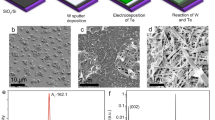Abstract
The development of technologically important material zinc-blende ZnO has been hindered due to the difficulties inherent in obtaining a stable zinc-blende phase. In this paper, we fabricate the stable zinc-blende ZnO on Pt/Ti/SiO2/Si substrate through phase transformation from the originally wurtzite to the zinc-blende phase. X-ray diffraction data in combination with high-resolution TEM measurements provide the direct evidence on the formation of the well-defined zinc-blende structure with predominated (202) orientation. According to the experimental results and first principles calculations, the incorporation of titanium dopants into ZnO system favors the formation of the zinc-blende structure. The platinum (Pt) surface stabilizes the ZnO zinc-blende structure at the interface (thin film) due to its low ZnO/Pt interface energy, preventing the decomposition in ZnO wurtzite and Zn2TiO4. Additionally, magnetic and optical properties of the ZnO zinc-blende thin films are investigated. Unexpectedly, the film is found to exhibit magnetization of ~75 emu/cm3, while its ZnO wurtzite counterpart is non-ferromagnetic.






Similar content being viewed by others
References
Pearton SJ, Norton DP, Ip K, Heo YW, Steiner T (2003) Recent progress in processing and properties of ZnO. Superlattices Microstruct 34(1–2):3–32. doi:10.1016/s0749-6063(03)00093-4
Herng TS, Kumar A, Ong CS, Feng YP, Lu YH, Zeng KY, Ding J (2012) Investigation of the non-volatile resistance change in noncentrosymmetric compounds. Sci Rep 2. doi:http://www.nature.com/srep/2012/120817/srep00587/abs/srep00587.html#supplementary-nformation
Ozgur U, Alivov YI, Liu C, Teke A, Reshchikov MA, Dogan S, Avrutin V, Cho S-J, Morkoc H (2005) A comprehensive review of ZnO materials and devices. J Appl Phys 98(4):041301-041103
Ashrafi A, Ueta A, Avramescu A, Kumano H, Suemune I, Ok YW, Seong TY (2000) Growth and characterization of hypothetical zinc-blende ZnO films on GaAs(001) substrates with ZnS buffer layers. Appl Phys Lett 76(5):550–552. doi:10.1063/1.125851
Lee GH, Kawazoe T, Ohtsu M (2002) Difference in optical bandgap between zinc-blende and wurtzite ZnO structure formed on sapphire (0001) substrate. Solid State Commun 124(5–6):163–165. doi:10.1016/s0038-1098(02)00537-9
Kim SK, Jeong SY, Cho CR (2003) Structural reconstruction of hexagonal to cubic ZnO films on Pt/Ti/SiO2/Si substrate by annealing. Appl Phys Lett 82(4):562–564. doi:10.1063/1.1536253
Ashrafi A, Jagadish C (2007) Review of zincblende ZnO: stability of metastable ZnO phases. J Appl Phys 102(7):071101
Lai YY, Lan YP, Lu TC (2013) Strong light-matter interaction in ZnO microcavities. Light-Sci Appl 2(6):e76. doi:10.1038/lsa.2013.32
Shimada R, Xie J, Avrutin V, Ozgur U, Morkoc H (2008) Cavity polaritons in ZnO-based hybrid microcavities. Appl Phys Lett 92(1):011127. doi:10.1063/1.2830022
Chen JR, Lu TC, Wu YC et al (2009) Large vacuum Rabi splitting in ZnO-based hybrid microcavities observed at room temperature. Appl Phys Lett 94:061103. doi:10.1063/1.3079398
Sturm C, Hilmer H, Schmidt-Grund R, Grundmann M (2009) Observation of strong exciton-photon coupling at temperatures up to 410 K. New J Phys 11(7):073044. doi:10.1088/1367-2630/11/7/073044
Chen JR, Lu TC, Wu YC et al (2011) Characteristics of exciton-polaritons in ZnO-based hybrid microcavities. Opt Express 19:4101. doi:10.1364/oe.19.004101
Orosz L, Reveret F, Bouchoule S et al (2011) Fabrication and optical properties of a fully-hybrid epitaxial ZnO-based microcavity in the strong-coupling regime. Appl Phys Express 4(7):072001. doi:10.1143/apex.4.072001
Lu TC, Lai YY, Lan YP et al (2012) Room temperature polariton lasing versus photon lasing in a ZnO-based hybrid microcavity. Opt Express 20:5530
Vanmaekelbergh D, van Vugt LK (2011) ZnO nanowire lasers. Nanoscale 3(7):2783–2800. doi:10.1039/c1nr00013f
Lee GH, Kawazoe T, Ohtsu M (2005) Room temperature near-field photoluminescence of zinc-blend and wurtzite ZnO structures. Appl Surf Sci 239(3–4):394–397. doi:10.1016/j.apsusc.2004.06.004
Kresse G, Furthmuller J (1996) Efficient iterative schemes for ab initio total-energy calculations using a plane-wave basis set. Phys Rev B 54(16):11169–11186. doi:10.1103/PhysRevB.54.11169
Monkhorst HJ, Pack JD (1976) Special points for brillouin-zone integrations. Phys Rev B 13(12):5188–5192. doi:10.1103/PhysRevB.13.5188
Teke A, Ozgur U, Dogan S, Gu X, Morkoc H, Nemeth B, Nause J, Everitt HO (2004) Excitonic fine structure and recombination dynamics in single-crystalline ZnO. Phys Rev B 70(19):195207. doi:10.1103/PhysRevB.70.195207
Catlow CRA, French SA, Sokol AA, Al-Sunaidi AA, Woodley SM (2008) Zinc oxide: a case study in contemporary computational solid state chemistry. J Comput Chem 29(13):2234–2249. doi:10.1002/jcc.21051
Tseng Y-C, Lin Y-J, Chang H-C, Chen Y-H, Liu C-J, Zou Y-Y (2012) Effects of Ti content on the optical and structural properties of the Ti-doped ZnO nanoparticles. J Lumin 132(2):491–494. doi:10.1016/j.jlumin.2011.08.016
Lin S-S, Huang J-L, Lii D-F (2005) Effect of substrate temperature on the properties of Ti-doped ZnO films by simultaneous rf and dc magnetron sputtering. Mater Chem Phys 90(1):22–30. doi:10.1016/j.matchemphys.2004.08.040
Li HX, Chen Q, Chen XP, Mao QN, Xi JH, Ji ZG (2013) Improvement of resistive switching in ZnO film by Ti doping. Thin Solid Films 537:279–284. doi:10.1016/j.tsf.2013.04.028
Zhong ZY, Zhang T (2013) Microstructure and optoelectronic properties of titanium-doped ZnO thin films prepared by magnetron sputtering. Mater Lett 96:237–239. doi:10.1016/j.matlet.2013.01.025
Lin YC, Hsu CY, Hung SK, Wen DC (2013) Influence of TiO2 buffer layer and post-annealing on the quality of Ti-doped ZnO thin films. Ceram Int 39(5):5795–5803. doi:10.1016/j.ceramint.2012.12.099
Needs RJ, Mansfield M (1989) Calculations of the surface stress tensor and surface-energy of the (111) surrfaces of iridium, platinum and gold. J Phys Condens Matter 1(41):7555–7563. doi:10.1088/0953-8984/1/41/006
Acknowledgements
This work is supported by A-Star SERC 1321202068, Singapore National Research Foundation under its Competitive Research Funding (NRF-CRP 8-2011-06 and NRF2008NRF-CRP002024), MOE-AcRF-Tier-2 (MOE2010-T2-2-121).
Author information
Authors and Affiliations
Corresponding author
Rights and permissions
About this article
Cite this article
Chichvarina, O., Herng, T.S., Phuah, K.C. et al. Stable zinc-blende ZnO thin films: formation and physical properties. J Mater Sci 50, 28–33 (2015). https://doi.org/10.1007/s10853-014-8561-0
Received:
Accepted:
Published:
Issue Date:
DOI: https://doi.org/10.1007/s10853-014-8561-0




